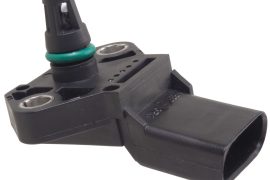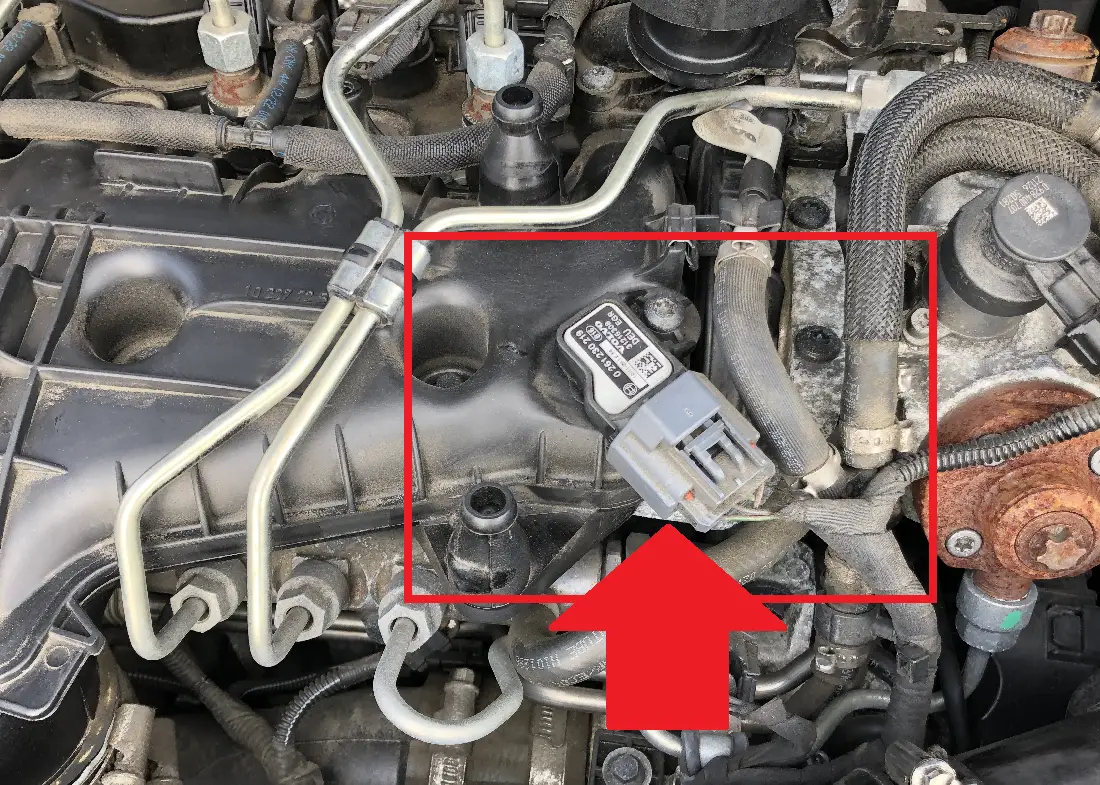To guarantee that the engine operates efficiently, your car is equipped with a number of sensors. These sensors report data to the powertrain control module (PCM) on the performance of various components. To maintain the air-fuel ratio and many other functions, the PCM makes use of the data from these sensors. Additionally, your car has a turbo boost pressure sensor. It senses the intake manifold’s boost pressure.
In this article, we’ll be talking more about the boost pressure sensor. Nevertheless, the answers to the following questions will be discussed:
- How does a boost pressure sensor work?
- What are the symptoms of a bad or failing boost pressure sensor?
- Where is this sensor located?
- How to test the sensor?
- How much does it cost to replace the boost pressure sensor?
So, let’s get started!
Contents
Understanding what a boost pressure sensor is
In order to control engine performance, turbocharged engines use boost pressure sensors to provide information on air pressure as well as air and fuel ratios. A boost pressure sensor has been an outstanding advancement in engine technology despite being a sophisticated piece of equipment. The amount of boost produced in the intake manifold of a turbocharged or supercharged engine is managed by boost pressure sensors. They have an impact on the air delivery pressure to the mechanical and pneumatic wastegate actuators.
How does a boost pressure sensor work?
Prior to the throttle valve, the boost pressure sensor monitors the absolute pressure. The engine control unit uses its signal to determine the boost pressure correction value. The electronic control unit, or ECU, of the vehicle can determine how much fuel is required in the combustion chamber to achieve the ideal air-fuel combination by sensing the amount of boost and air density in the intake manifold.
Engines must have the proper air-fuel ratio since this results in higher, more efficient power production. This increases the engine’s power while also improving its efficiency and utilizing every last drop of fuel. Low manifold pressure (high vacuum) causes the sensor voltage output at the ECM to range from 0.25 to 1.8 volts.
Sensor voltage output ranges from 2.0 to 4.7V when turbo boost is causing a high intake manifold pressure. The range of pressure is 10 kPa to 350 kPa. The ECM provides a 5V reference to the sensor. The ECM also supplies sensor ground. The ECM calculates the amount of air entering the engine based on boost pressure and intake air temperature.
What are the symptoms of a bad or failing boost pressure sensor?
The following are the most common symptoms of a bad or failing boost pressure sensor:
Rough Idling
One of the typical signs of a faulty turbo boost pressure sensor is rough idling. This sensor aids in regulating the entry of fuel and air into the combustion chamber. An incorrect air-fuel ratio might result in severe idling engine vibrations or erratic jumps in idle speed.
Check engine light on
One of the most prevalent indications of a faulty turbo boost pressure sensor is the lighting of the check engine light. Your PCM may specifically set off the P0236 code when it discovers a malfunctioning boost pressure sensor. Check your vehicle’s pressure sensor right away if you have this engine code.
The P0236 error code, however, may occur for various reasons. You must rule out any potential electrical issues and confirm that the supercharger or turbocharger is operating effectively. The boost pressure sensor will function as it should in such a situation and notify you of any potential issues.
Engine performance either increasing or decreasing
The PCM needs to know the real performance of the supercharger or turbocharger, which is the primary job of the turbo boost pressure sensor. The PCM will change to an inaccurate reading as a result, reducing or enhancing the overall performance of your engine depending on whether this sensor accurately reports the supercharger or turbo’s performance.
Engine deterioration may happen in both supercharged and turbocharged engines, however, a faulty boost pressure sensor may cause the turbocharged engine to function far worse than the supercharged engine. This is because, in the case of a supercharged engine, the PCM is unable to enhance the engine’s performance because it is unaware of the supercharger’s capability.
However, in turbocharged engines, the PCM may completely drop the turbo pressure, which dramatically lowers engine performance. Rarely, your PCM may also boost the turbo pressure, which causes your turbo engine to run better. This could seriously harm your engine’s internal components. Consequently, you should fix a bad boost pressure sensor as soon as you can.
Difficulty starting
A bad BPS sensor can potentially affect how the engine starts. Before starting the engine, the PCM in your car uses the data from the boost pressure sensor to calculate the air pressure. Because the precise air-fuel mixture is crucial for the engine to start, an inaccurate reading could result in the engine receiving too little fuel, which could prevent it from starting at all.
Reduction or increase of boost pressure
A faulty boost pressure sensor could increase or reduce engine performance, as described in the aforementioned symptoms. An alteration in the turbo pressure is what causes this. There aren’t many cars that have a turbo gauge that shows the turbo pressure right now. You may undoubtedly have a malfunctioning boost sensor if you notice that the pressure is more or lower than usual when the engine is under heavy load.
Emission test failure
A faulty boost pressure sensor may result in your vehicle failing the emissions test if you live in a region where passing an emissions test is a requirement for registering your car. The check engine light may come on or exhaust gas emissions may increase as a result of a damaged BPS sensor.
Where is this sensor located?
Most frequently, the boost pressure sensor is found in the boost pipes that connect the turbocharger and intake manifold. Some automobiles could also have this sensor mounted in the intake manifold. The sensor may be able to record the turbocharger or supercharger’s boost pressure here without any interference.
It’s a relatively simple location towards the top of the engine, but you might need to take out a few other components to get to it. The boost pressure sensor, however, is the component that is the simplest to locate and access in various car types.
How to test the sensor?
We’ll conduct 2 different tests on the boost pressure sensor: The supply voltage test and the output signal test.
Supply voltage test:
- From the sensor, disconnect the plug.
- Turn the ignition on.
- Set “DC voltage” on the multimeter.
- Take a supply voltage reading between ground A (1) and pin C (3). It ought to be around 5V.
- Find the source of the voltage supply’s problem if this value is not reached.
Output signal test:
- From the intake manifold, remove the pressure sensor.
- Connect the vacuum hand pump to the pressure sensor.
- Turn the ignition on.
- Select “DC voltage” on the multimeter.
- Set the lower absolute pressure value P-low.
- Between pin B (2) and earth A (1), test the lower output signal U-low.
- Set the P-high upper limit for absolute pressure.
- Between pin B (2) and earth A (1), test the higher output signal U-high.
How much does it cost to replace the boost pressure sensor?
The cost to replace the turbo boost pressure sensor varies depending on your location, the cost of labor, and the manufacturer of the part. An average boost pressure sensor replacement costs between $170 and $220.
Related Article
- Symptoms of a faulty map sensor
- Symptoms Of a Bad Crankshaft Position Sensor
- Understanding Knock Sensor
- Getting To Know the MAP Sensor
- Understanding Boost Pressure Sensor
- Everything You Need to Know About Fuel Rail Pressure Sensor
- Everything you need to know about coolant temperature sensor
Watch the video below to learn more
FAQs
What are the three causes of low boost pressure?
Low boost pressure may be caused by broken hoses, contamination accumulation in the turbine or compressor areas, leaking seals, damaged shaft bearings, the wastegate sticking open or working improperly, an intercooler leak, clogged air filters, damaged diesel particulate filters, or damaged catalytic converters.
What sensor detects boost pressure?
Between the turbocharger and engine is an air intake pipe called an “inlet manifold” that houses a boost pressure sensor and a temperature sensor. This sensor monitors absolute pressure. It is possible to measure the intake air mass more precisely by taking the intake air temperature into account.
What is boost pressure in an engine?
Boost pressure pushes more air into your engine, increasing power in the process. Your engine can produce more power the more air you can force into it. However, a boost pressure that is too high can seriously harm your engine.
What happens when a boost sensor fails?
Your car may exhibit the following signs of a failed turbo boost pressure sensor: inadequate power. sluggish acceleration or pauses. erratic idle.
How does a boost pressure sensor work?
Before the throttle valve, the boost pressure sensor gauges the absolute pressure. The engine control unit uses its signal to determine the boost pressure correction value.
How do you test a boost sensor?
In order to confirm the BPS’s functionality
- From the sensor, disconnect the plug.
- Turn the ignition on.
- Select “DC voltage” on the multimeter.
- Take a supply voltage reading between ground A (1) and pin C (3). It ought to be around 5V. If this value is not achieved, the voltage supply fault must be found.
Can you clean a boost sensor?
Either gasoline or alcohol will clean it. When you’re done, you can put it back and reset the ECM’s adaptation data, which is advised.
How do you diagnose boost problems?
You can listen with a pressure tester for any strange noises, such as air escaping, which is an obvious sign that your automobile is losing boost pressure. Making or using an intake leak test on any engine, whether it is boosted or just naturally aspirated, can be a very smart idea.
Final words
To sum up, the boost pressure sensor is an essential component of contemporary automobile engines. It helps to enhance engine performance and fuel efficiency by measuring and monitoring the air pressure in the intake manifold. The engine will run more smoothly and emit fewer emissions if this crucial component makes sure it gets the proper amount of air and fuel. All things considered, the boost pressure sensor is an essential device for increasing engine economy and improving the driving experience.
And that is all for this article, in which we talked about the boost pressure sensor. Nonetheless, the answers to the following questions will be discussed:
- How does a boost pressure sensor work?
- What are the symptoms of a bad or failing boost pressure sensor?
- Where is this sensor located?
- How to test the sensor?
- How much does it cost to replace the boost pressure sensor?
Hope you learn a lot from the reading. If you do, kindly share it with others. Thanks for reading; see you around!

